
(a)
Interpretation: The number of triple points in the given phase diagram of sulfur needs to be determined.
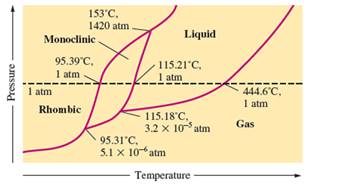
Concept Introduction:
The conversion of
The heating -cooling curve is the curve of temperature v/s time that interpret the change in the states of matter with increase in temperature.
The phase diagram represents the change in the physical state of given substance with temperature and pressure.
(a)
Answer to Problem 104E
There are three triple points in the given phase diagram of sulfur.
Explanation of Solution
A triple point is the point in the phase diagram at which all the three phases will join together. It indicates the point (temperature and pressure) at which all three states remain in equilibrium.
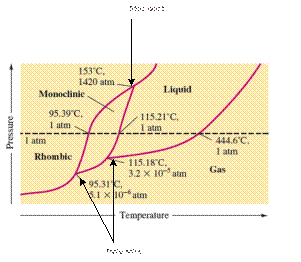
(b)
Interpretation: The phases at the triple points in the given phase diagram of sulfur needs to be determined.

Concept Introduction:
The conversion of solid to liquid and gas involves the change in temperature that can display in heat curve.
The heating -cooling curve is the curve of temperature v/s time that interpret the change in the states of matter with increase in temperature.
The phase diagram represents the change in the physical state of given substance with temperature and pressure.
(b)
Answer to Problem 104E
- At 95.31°C: rhombic, monoclinic, gas
- At 115.18°C: monoclinic, liquid, gas
- At 153°C: rhombic, monoclinic, and liquid
Explanation of Solution
A triple point is the point in the phase diagram at which all the three phases will join together. It indicates the point (temperature and pressure) at which all three states remain in equilibrium.
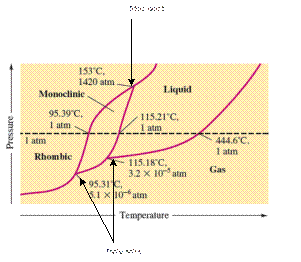
At 95.31°C, the rhombic, monoclinic and gaseous state of sulfur are in equilibrium whereas at 115.18°C monoclinic, liquid and gaseous state of sulfur. The 3rd triple point is at 153°C at which rhombic, monoclinic, and liquid state of sulfur.
(c)
Interpretation: The phases which are stable at room temperature and 1.0 atm pressure in the given phase diagram of sulfur needs to be determined.

Concept Introduction:
The conversion of solid to liquid and gas involves the change in temperature that can display in heat curve.
The heating -cooling curve is the curve of temperature v/s time that interpret the change in the states of matter with increase in temperature.
The phase diagram represents the change in the physical state of given substance with temperature and pressure.
(c)
Answer to Problem 104E
At room temperature and 1.0 atm pressure,the rhombic phase of sulfur is stable. The temperature is approximately ˜ 20°C and pressure is 1.0 atm.
Explanation of Solution
In the given phase diagram, there are four states of sulfur; monoclinic, rhombic, liquid and gaseous state of sulfur.
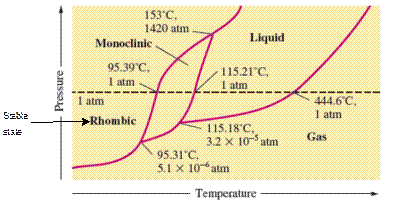
At room temperature and 1.0 atm pressure, the rhombic phase of sulfur is stable. The temperature is approximately ˜ 20°C and pressure is 1.0 atm.
(d)
Interpretation: The possibility of existence of monoclinic sulfur in equilibrium with sulfur vapor needs to be determined.

Concept Introduction:
The conversion of solid to liquid and gas involves the change in temperature that can display in heat curve.
The heating -cooling curve is the curve of temperature v/s time that interpret the change in the states of matter with increase in temperature.
The phase diagram represents the change in the physical state of given substance with temperature and pressure.
(d)
Answer to Problem 104E
The monoclinic sulfur and vapor or gaseous state of matter share the phase line therefore they can be in equilibrium in the phase diagram.
Explanation of Solution
In the given phase diagram, there are four states of sulfur; monoclinic, rhombic, liquid and gaseous state of sulfur. The monoclinic sulfur and vapor or gaseous state of matter share the phase line therefore they can be in equilibrium in the phase diagram.
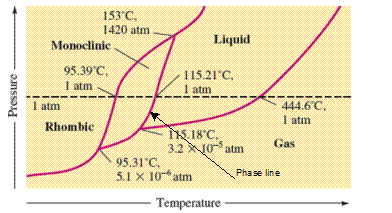
(e)
Interpretation: The normal boiling point and normal melting point of sulfur according to given phase diagram needs to be determined.
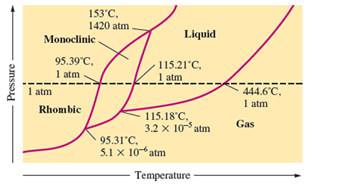
Concept Introduction:
The conversion of solid to liquid and gas involves the change in temperature that can display in heat curve.
The heating -cooling curve is the curve of temperature v/s time that interpret the change in the states of matter with increase in temperature.
The phase diagram represents the change in the physical state of given substance with temperature and pressure.
(e)
Answer to Problem 104E
Normal melting point = 115.21°C
Normal boiling point = 444.6°C
Explanation of Solution
In the given phase diagram, there are four states of sulfur; monoclinic, rhombic, liquid and gaseous state of sulfur. Boiling point is the temperature at which liquid and gaseous state remain in equilibrium at 1 atm pressure. According to given phase diagram, the normal boiling point of sulfur must be 444.6°C. The melting point of substance is the temperature at which solid melts to liquid state which is 115.21 °C for sulfur.
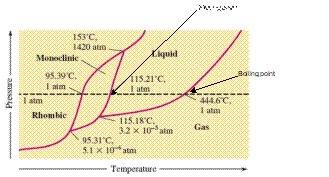
(f)
Interpretation: The denser phase out of solid, monoclinic or rhombic sulfur according to given phase diagram needs to be determined.
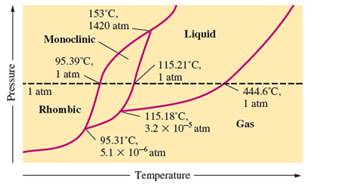
Concept Introduction:
The conversion of solid to liquid and gas involves the change in temperature that can display in heat curve.
The heating -cooling curve is the curve of temperature v/s time that interpret the change in the states of matter with increase in temperature.
The phase diagram represents the change in the physical state of given substance with temperature and pressure.
(f)
Answer to Problem 104E
Rhombic sulfur is the densest phase of sulfur.
Explanation of Solution
In the given phase diagram, there are four states of sulfur; monoclinic, rhombic, liquid and gaseous state of sulfur. The Rhombic phase of sulfur is most dense phase of it compare to monoclinic and solid. This is because the rhombic-monoclinic equilibrium line has a positive slope therefore with increase in the temperature, the rhombic phase changes to monoclinic.
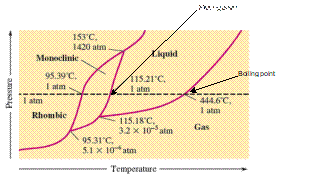
Want to see more full solutions like this?
Chapter 16 Solutions
Chemical Principles
- An amorphous solid can sometimes be converted to a crystalline solid by a process called annealing. Annealing consists of heating the substance to a temperature just below the melting point of the crystalline form and then cooling it slowly. Explain why this process helps produce a crystalline solid.arrow_forwardUse the phase diagram for sulfur for Question 75. The solid forms of sulfur are rhombic and monoclinic. (a) A triple point is defined as a temperature and pressure where three phases are in equilibrium. How many triple points does sulfur have? Indicate the approximate temperature and pressure at each. (b) Which physical states are present at equilibrium under these conditions? (i) 102 atm and 80 C (ii) 101 atm and 140 C (iii) 103 atm and 110 C (iv) 104 atm and 160 C Phase diagram for sulfur, for Question 75.arrow_forwardAt 20. C the vapor pressure of white phosphorus is 0.0254 mmHg; at 40. C it is 0.133 mmHg. Use the Clausius-Clapeyron equation to estimate the heat of sublimation (J/mol) of white phosphorus.arrow_forward
- A common prank on college campuses is to switch the salt and sugar on dining hall tables, which is usually easy because the substances look so much alike. Yet, despite the similarity in their appearance, these two substances differ greatly in their properties, since one is a molecular solid and the other is an ionic solid. How do the properties differ and why?arrow_forwardElemental carbon has one gas phase, one liquid phase, and two different solid phases, as shown in the phase diagram: (a) On the phase diagram, label the gas and liquid regions. (b) Graphite is the most stable phase of carbon at normal conditions. On the phase diagram, label the graphite phase. (c) If graphite at normal conditions is heated to 2500 K while the pressure is increased to 1010 Pa, it is converted into diamond. Label the diamond phase. (d) Circle each triple point on the phase diagram. (e) In what phase does carbon exist at 5000 K and 108 Pa? (f) If the temperature of a sample of carbon increases from 3000 K to 5000 K at a constant pressure of 106 Pa, which phase transition occurs, if any?arrow_forwardAs minerals were formed from the molten magma, different ions occupied the same cites in the crystals. Lithium often occurs along with magnesium in minerals despite the difference in the charge on their ions. Suggest an explanation.arrow_forward
- Phase diagrams for materials that have allotropes can be more complicated than those shown in the chapter. Use the phase diagram for carbon given here to answer the following questions. (a) How many triple points are present and what phases are in equilibrium for each? (b) Is there a single point where all four phases are in equilibrium? (c) Which is more stable at high pressures, diamond or graphite? (d) Which is the stable phase of carbon at room temperature and 1 atmosphere pressure?arrow_forwardThe phase diagram for elemental sulfur is shown in Figure 6.18. Figure 6.18 Phase diagram for elemental sulfur. a How many allotropes are shown? b What is the stable allotrope of sulfur under normal conditions of temperature and pressure? c Describe the changes to sulfur as its temperature is increased from 25C while at 1atm pressure.arrow_forwardIf you've ever opened a bottle of rubbing alcohol or other solvent on a warm day, you may have heard a little “whoosh” as the vapor that had built up above the liquid escapes. Describe on a microscopic basis how a vapor pressure builds up in a closed container above a liquid. What processes in the container give rise to this phenomenon?arrow_forward
- Silicon carbide, SiC, is a very hard, high-melting solid. What kind of crystal forces account for these properties?arrow_forwardAnswer the following questions using Figure 11.12: (a) What is the approximate equilibrium vapor pressure of water at 60 C? Compare your answer with the data in Appendix G. (b) At what temperature does water have an equilibrium vapor pressure of 600 mm Hg? (c) Compare the equilibrium vapor pressures of water and ethanol at 70 C. Which is higher? Figure 11.12 Vapor pressure curves for diethyl ether [(C2H3)2O], ethanol (C2H5OH), and water. Each curve represents conditions of T and P of which the two phases, liquid and vapor, are in equilibrium. These compounds exist as liquids for temperatures and pressures to the left of the curve and as gases under conditions to the right of the curve. (See Appendix G for vapor pressures for water of various temperatures.)arrow_forward
 Chemistry: An Atoms First ApproachChemistryISBN:9781305079243Author:Steven S. Zumdahl, Susan A. ZumdahlPublisher:Cengage Learning
Chemistry: An Atoms First ApproachChemistryISBN:9781305079243Author:Steven S. Zumdahl, Susan A. ZumdahlPublisher:Cengage Learning
 ChemistryChemistryISBN:9781305957404Author:Steven S. Zumdahl, Susan A. Zumdahl, Donald J. DeCostePublisher:Cengage Learning
ChemistryChemistryISBN:9781305957404Author:Steven S. Zumdahl, Susan A. Zumdahl, Donald J. DeCostePublisher:Cengage Learning Chemistry: The Molecular ScienceChemistryISBN:9781285199047Author:John W. Moore, Conrad L. StanitskiPublisher:Cengage Learning
Chemistry: The Molecular ScienceChemistryISBN:9781285199047Author:John W. Moore, Conrad L. StanitskiPublisher:Cengage Learning Chemistry & Chemical ReactivityChemistryISBN:9781133949640Author:John C. Kotz, Paul M. Treichel, John Townsend, David TreichelPublisher:Cengage Learning
Chemistry & Chemical ReactivityChemistryISBN:9781133949640Author:John C. Kotz, Paul M. Treichel, John Townsend, David TreichelPublisher:Cengage Learning Physical ChemistryChemistryISBN:9781133958437Author:Ball, David W. (david Warren), BAER, TomasPublisher:Wadsworth Cengage Learning,
Physical ChemistryChemistryISBN:9781133958437Author:Ball, David W. (david Warren), BAER, TomasPublisher:Wadsworth Cengage Learning,





